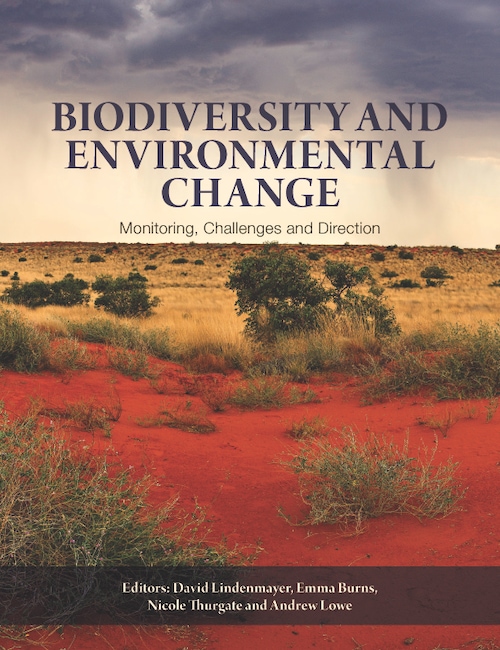A landmark book publication brings together for the first time decades of environment monitoring work from across the entire country, documenting the changes, identifying the drivers of change and providing the evidence and knowledge needed to inform better natural resource management in Australia.

Biodiversity and Environmental Change: monitoring, challenges and direction, was published by CSIRO Publishing in January 2014.
It describes changes in a range of Australian ecosystems that have been subject to detailed long-term research. The overarching purpose of these long-term studies has been to document the changes, identify the drivers of change and provide the evidence and knowledge needed to inform better natural resource management in Australia.
No matter how hard they might try, it is impossible for one person or agency to tackle alone the problems of science and management posed by Australia’s ecosystems. In fact the 2011 State of the Environment Report pointed out that even assessing the state of Australia’s ecosystems was difficult, primarily because ecosystem data is scattered and often inaccessible. Now that TERN’s infrastructure is maturing, however, the scope for collaboration between farflung stakeholders is dramatically improved.
Several TERN facilities conduct on-ground terrestrial ecosystem data collection—the Long Term Ecological Research Network (LTERN), the Australian SuperSite Network, the Australian Transect Network, and AusPlots are examples. These facilities span a monitoring spectrum, from broad-scale surveillance monitoring to intensive long-term ecological research, all of which provide vital information about our continent.
In November 2011 these facilities met and agreed to the idea of producing a book to synthesise and present their work to a wider audience and to provide scientifically robust information to policy makers. The primary focus of the book is on ecological monitoring underpinned by TERN. In particular it illustrates, and emphasises, the importance of long-term data. In a bid to include long-term information from a diverse number of Australian ecosystems, a broad range of authors from across TERN were involved. However, as the book evolved many other authors were invited to contribute, and a total of 84 environmental professionals, the majority of whom were not directly affiliated with TERN contributed. . These included professionals from academic institutions, state and territory governments, the CSIRO, pastoral companies, consultants and non-government organisations.
The resulting book, Biodiversity and Environmental Change: monitoring, challenges and direction, was published by CSIRO Publishing in January 2014. The book, demonstrates the value of long-term ecological research for monitoring environmental and biodiversity change in Australia. The overarching purpose of these long-term studies has been to document the changes, identify the drivers of change and provide the evidence and knowledge needed to inform better natural resource management in Australia.

Download the book’s Policy Handbook (4MB)
This handbook describes the key findings and messages from long-term ecological research for policy makers and the general public.
Associate Professor Glenda Wardle, an LTERN researcher from the University of Sydney, describes our book as ‘a tapestry in the sense that it is both beautiful and practical – that probably started out as more of a patchwork quilt.’
‘We looked far and wide for the best information and respectfully collaborated to bring the idiosyncratic pieces of information into a cohesive whole. Readers will discover there are common threads across the various biomes but that the distinctiveness of each is retained,’ says Glenda.
‘The book is only the beginning, not the end,’ says Dr Emma Burns, one of our book’s editors and LTERN’s Executive Director. ‘The real task is facilitating the uptake of its content into policy, and building a more inclusive and synthesised picture.’ To help this process along, a companion policy handbook has also been released, which describes the key findings and messages from long-term ecological research for policy makers and the general public.
Our book is a unique contribution in many ways, but one of the most significant outcomes is well articulated by Glenda. ‘For the first time we’ve published what we know about Australian ecosystems, but just as importantly also what we don’t,’ she says.
This information will be crucial to steering environmental policy across Australia, by providing a long-term view that helps integrate changes across landscapes.
Another unique feature of our book is that it includes not just scientific information but considers the importance of people and culture in environmental management. Australia’s ecosystems are influenced by a range of drivers of change and it is important to remember that humans sit at the centre of these.
The rapid creation and production of our book is testament to the passion and commitment of all the individuals that worked on it. However it was primarily TERN researchers and staff that coordinated and provided a back-bone for all contributors to come together and produce a unique product. Without the TERN infrastructure it is unlikely such an ambitious project would have come to fruition.
A number of articles in this newsletter feature parts of our book, including its science, but the contributions of the people involved will stand as an enduring legacy to Aristotle’s phrase ‘The whole is greater than the sum of its parts.’
Published in TERN newsletter April 2015






